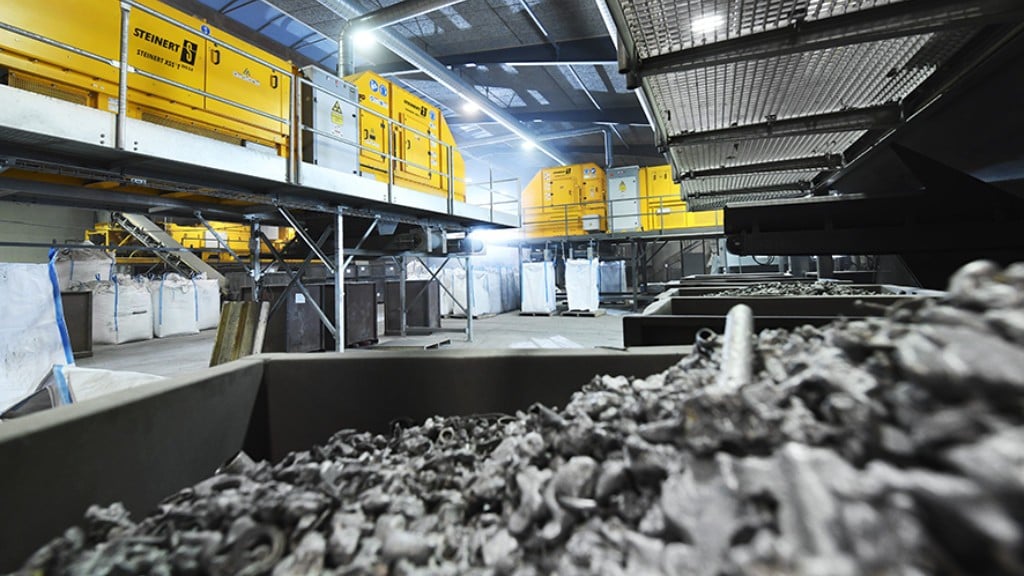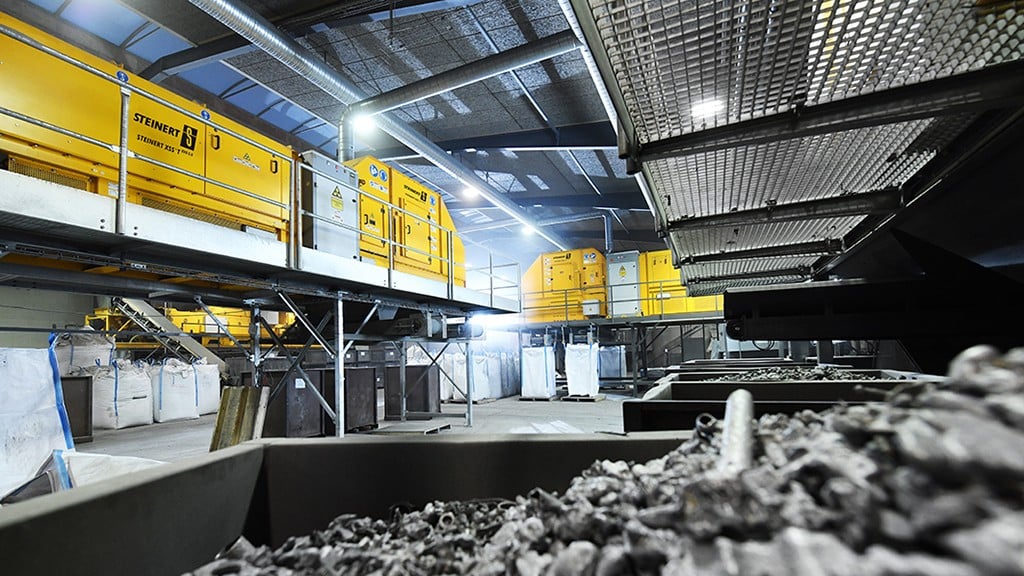How the right sorting technology and know-how can make aluminum greener
An interview with Steinert's Global Sales Director, Metal Recycling, Karl Hoffmann

In this Q&A, Karl Hoffmann, Global Sales Director from the Metal Recycling Division at STEINERT, talks about the nature of recycling aluminium, technological breakthroughs in the sector, the distinctive features of end markets for recovered aluminum, and his expectations for the future.
What does the term "Greener Aluminium" mean exactly?
Karl Hoffman (KH): "Greener Aluminium" highlights the opportunities, which this metal and its unique possibilities offer us in recycling. This does require intelligent recycling cycles and sorting technology, but it is already allowing us to produce closed material cycles for this important material.
How can so much energy be saved by recycling aluminium?
KH: Basically, you have to compare primary and secondary aluminium. In the case of primary aluminium, firstly bauxite has to be mined and then a complex process is undertaken to produce aluminium oxide from this. The molten salt electrolysis process then produces aluminium with a purity of up to 99.7 percent. This is a very energy-intensive process, which causes a lot of environmental pollution.
Recycling is brought into the equation when producing secondary aluminium. By using scrap aluminium in smelting works, much less energy is used. What's more, the aluminium can be used again and again - in theory, it can be recycled infinitely. And the figures involved are significant: around 75 percent of the aluminium ever produced is still in circulation. This is firstly because products made from aluminium have a long life and secondly because metal can be recycled with great ease.
How much less energy is needed to recycle aluminium compared with producing it from scratch?
KH: You can assume an energy savings of up to 95 percent. Of course, this is great news for climate protection. Recycling aluminium has the potential to produce 92 percent fewer CO2 emissions than new aluminium. In 2019, 20 million tonnes of aluminium was recycled globally, which equivalent to saving of 300 million tonnes of greenhouse gases.
Processing one tonne of aluminium scrap also saves 8 tonnes of bauxite from having to be mined. All things considered, it's a saving of 14,000 kWh.
Why are we producing any new aluminium at all?
KH: These days to be able to produce certain quality alloys, we still need primary aluminium, the manufacturing process for which is highly energy intensive. Maintaining high quality levels for recycled aluminium requires intelligent cycles using highly efficient recycling technologies, such as sensor-based sorting technology. This can then compensate for the downgrading of material qualities experienced in the recycling cycle, which also enables secondary aluminium to be efficiently used in the production of what are known as aluminium wrought alloys.
What are the importance of aluminium alloys?
KH: There are hundreds of different alloys and, depending on the requirements of the application in question, they provide various mechanical properties, such as strength or hardness. Developments in this field are highly dynamic. In the automotive sector, for example, it has long been standard to produce body parts from aluminium. And now, supporting parts, like suspensions are being manufactured out of recently developed aluminium alloys or even aluminium compounds.
Of course, the engine itself is already mainly made from cast aluminium. Several automotive manufacturers have already honed in on aluminium as a material. Aluminium's lower weight helps them comply with ever tighter CO2 emission requirements; the density of aluminium is 2.7 times less that of steel.
Aluminium will also be a key material for electric vehicles. The more steel is replaced with aluminium, the greater the range of an electric vehicle. Its potential for the future is huge too.
Alongside these large potential savings in CO2 emissions driven by lightweight design in the automotive sector, this potential will also be boosted by the efficient and specific use of recycled aluminium to reduce greenhouse gases. For this to happen, precise sorting technology is essential for ensuring high-quality recycled goods.
How do you ensure as high a grade of aluminium as possible from recycling?
KH: It goes without saying that this depends a great deal on the input material. The quality needed of course also depends on its intended use. Course impurities, like plastics or wood, can be removed with relatively simple technology, involving eddy current separators.
Sensors can sort to a much finer degree. X-ray transmission technology is basically the same as that used in the medical profession where the absorption of x-ray radiation makes different material densities visible. When sorting metal, this means that pieces of metal on a conveyor belt can be radiated and classified into materials and purity levels with a high degree of accuracy.
The huge advances made in detection, software and the processing of signals deliver a combination of very accurate sorting and high speed. Compressed air is then used to separate good parts out from not so good ones.
What happens with sorted aluminum material?
KH: Smelting plants buy the metal to process it further. But there is also an option of further sorting the aluminium into alloys. The more precisely this is done, the more specifically the material can be used. We then inch ever closer to the goal of a closed cycle, in other words, a circular economy.
What technological advances for sorting aluminum have been made recently at Steinert?
KH: Not long ago, we updated our system with x-ray transmission technology. We call the system XSS, which stands for x-ray and sensor sorting, the latest innovation bears the add-on EVO technology. This embodies developments made over the last five years. For example, we are now able to detect various material characteristics much more precisely than was previously the case. This is mainly thanks to enhanced signal processing.
Nowadays, the systems are able to better separate out certain alloys. What's more, we are also now able to separate free magnesium, a metal that is frequently found in aluminium scrap and if not detected causes considerable extra work in aluminium smelting works. This is challenging because, like aluminium, magnesium is a light metal and its absorption coefficients for x-ray radiation are therefore very similar.
Have you made any other breakthroughs?
KH: Yes, we have made the components in our systems even more durable. The x-ray source, a key and costly component, for example, now comes with a four-year warranty, which is unique in the sector.
What is happening in aluminum markets currently?
KH: Light metals allow weight and therefore CO2 to be saved in the mobility sector. The statutory requirements in this area are getting more and more stringent all the time so there is growing pressure on OEMs to implement lightweight solutions.
At the same time, there is more and more interest from society in sustainable economies. Aluminium recyclers are therefore increasingly stating the share of recycled aluminium used. It can be assumed that demand for aluminium over the next few decades will increase by another 50 percent. An above-average amount of this will have to come from recycled material.
Around 5 million tons of aluminium scrap is currently recycled yearly, in Europe alone. The figure globally is 20 million tons. Experts estimate that this figure will double over the next 10 years.
What trends do you see emerging for aluminium recycling?
KH: Most of the material we sort today comes from vehicles or other products that were manufactured ten or more years ago. The number of alloys used has increased since then. So in the future, it will be important to be able to distinguish between alloys more accurately than we can today.
Are there any technological solutions, which would simplify the recycling of all these alloys?
KH: Yes, and we have already developed them: Laser-Induced Breakdown Spectroscopy or LIBS for short. This involves firing at aluminium with a high-energy laser. When the laser hits the metal, it turns into a metal vapour known as plasma. As it cools, it implodes and emits a measurable energy radiation, which is specific to that atom structure. This allows various aluminium alloys to be determined with great accuracy.
If this technology is introduced across the board, we will be able to separate alloys from one another so precisely that a circular economy is possible. The smelt works know what they need for their alloys. If a company can determine exactly what kind of material they have, then they can also establish what needs to be added to achieve the specified material properties.



